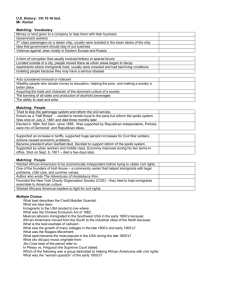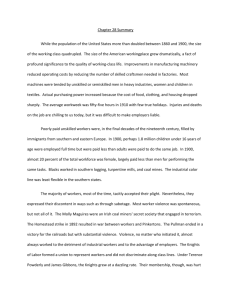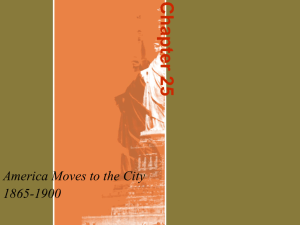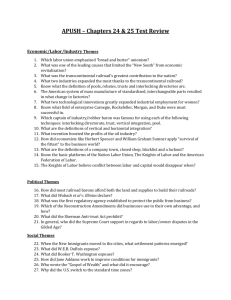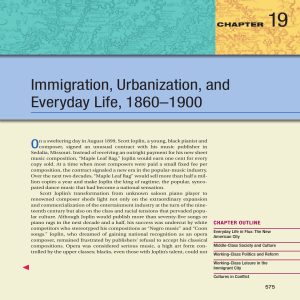Lecture S3 -- Industrialization and Immigration in the
advertisement
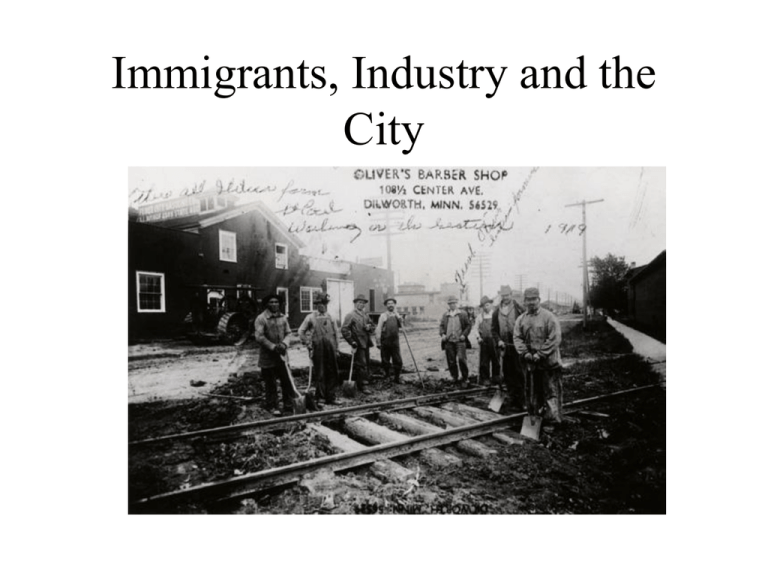
Immigrants, Industry and the City Background of Industrial Revolution • • • • • • • • War of 1812 Transportation Revolution Textiles Artifical Power Mechanization of Production Replaceable Parts Factory Production Destruction of the Artisan Class Inventing Technology • Thomas Edison • Chemistry – Charles Goodyear (Vulcanization of Rubber) -1839 – John Wesley Hyatt--Celluloid--1863 – Leo Hendrik Baekeland -- Bakelite -- 1909 – DuPont Corporation • Information Technology Rising Industry • Agriculture – $1.5 billion in 1870; $7.5 billion by 1919 • Fuels • Infrastructure • Rising Factories: – 1859: 140,000 – 1914: 268,000 Industry • Steel – Bessemer Steel and Open Hearth Techniques – Applications – Rise: 13,000 tons in 1860 --> 1910: 28 million • Andrew Carnegie • Meatpacking and other Processed Foods The Corporations • • • • Outlives its founders Limited liability of owners Fictive Legal Person Vertical Integration – Meatpacking • Horizontal Integration – Standard Oil Financing the Industrial Revolution • • • • • Greenbacks Silver Rise of Wall Street Bonds Mergers – Pools – Trusts – Holding Companies Changes in Retailing • • • • • Fixed Prices Replace Haggling General Store Department Store Chain Store Mail-Order House Creation of Modern Labor Force • • • • • • • 1870-1900 Transition Undercutting Artisans Multi-Job Families Unsafe Conditions Wage Issues Work Insecurity Long Hours Female Labor • 1880: 2.6 of 17.4 million workers are women • 1900: 85% of female labor are unmarried and 25 or younger • No Family Wage • Inadequate Female Wages Limited Professions • Teachers • Nurses • Social Work – Social Housekeeping • Domestics Child Labor • 4% of non-farm workforce in 1900 • Due to inadequacy of Adult Wages • Protests begin in 1890 Women’s Entertainments Business Ethics: The Self-Made Man • The Algerian Dream • Personal Property and Self Mastery • Roots in American Experience Business Ethics: Crush Everyone Else • Laisez Faire • Social Darwinism • Contradictions: – Big Businesses had hard to overcome edge – Businesses loved government help--for them. – Businessmen hated competition and loved monopolies...if they ran them. The Gospel of Wealth • • • • Andrew Carnegie Advocated intelligent philanthrophy Creation of institutions of self-improvement Discouraged redistribution of wealth and poverty assistance charities • Rejected leaving your fortune to your kids – Say no to Paris Hilton, etc. Unions • • • • • • • National Labor Union (1865-1873) Knights of Labor (1871-1932) American Federation of Labor (1886- ) Strikes Great Uprising / 1877 Railroad Strike Homestead Steel Strike (1892) 1900: 7% of workers (3/4ths were AFL) Supreme Court Backs Big Business • Slaughterhouse Cases (1873) • Munn vs. Illinois (1877) • Santa Clar Co. V. Southern Pacific Railroad (1886) • Wabash, St. Louis & Pacific Railroad Company vs. Illinois (1886) • Pollock v. Farmers Loan and Trust Company (1895) First Efforts at Regulation • Interstate Commerce Commission (1887) – 1897 Maximum Freight Rates Case • Sherman Anti-Trust Act (1890) – United States vs. E. C. Knight (1895) Immigration Immigrants: Western US • Japanese: 50,000 by 1900 – Farm Labor • Chinese: 125,000 by 1882 – Mining, Railroads, and Support Businesses – Called California ‘Gold Mountain’ – “Chinese Food” Chinese Gold Miners Eastern US Immigration • • • • • Italians Jews Slavs Greeks Many are Catholic or Greek Orthodox Greek Immigrants in Ethnic Dress Immigrant Communities • • • • Women’s Roles Ghettos / Ethnic Neighborhoods Religion and Fraternal Organizations Linguistic Enclaves Italian Society Parade Internal Migration • The Push West – 1900: The Frontier Closes • “The Great Migration” – – – – Moving North Work Opportunities Ghettos Communal Institutions The American City: Growth • 1860: 25 million Rural / 6.2 mil Urban • 1910: 50 million Rural / 42 mil Urban – 3 Cities: 1 million + – 5: 500,000 - 999,000 • New Immigrants • Rural Migration The American City: Neighborhood Specialization • Districting • Suburbs • Urban Transportation: – – – – – Streetcards Elevated Rail Electric Streetcar Subways Effects Problems • Wastes – Improved Sewage – 1910: 10 out of 42 million Americans have access to clean water • Tenements – – – – Poorly made Poorly insulated No fire codes Cramped Crime • • • • Mostly Urban Murders Quadruple (Lead?) Slums Prostitution – Regulators – White Slavery Panic – Anti-Vice Crusaders Political Machines • • • • • Urban Immigrants Bosses Corruption Social Services Upper Class Protest New Urban Architecture • • • • Technology Skyscrapers Style Louis Sullivan Education • • • • • • Innovators Country vs. City Rise of High Schools Classical vs. Modern Curricula Assimilation Universities – Land Grant and Co-Ed Universities Sports: Baseball • 1840: NYC Area • Pro Ball: 1869--Cincinnati Red Stockings • National League (1880s) - 8 million spectators / year • 1899: American League • 1903: First World Series (Boston Americans (AL) vs Pittsburgh Pirates (NL), 5-3 games. Entertainment • • • • • Theatre: Melodrama --> Realism Music Orchestras Black Music (Ragtime) New Theatre Forms Motion Pictures • Thomas Edison (1890s) • 1895: First projected movies • 1903: Great Train Robbery -- First full story • 1905: 3,000 movie theatres • 1914: 13,000 movie theatres / 5-7 million patrons a day Sports • • • • • • • Urban Need for Exercise and Entertainment Basketball (1891) Bicycling (1890s) Blue Laws Boxing (Jack Johnson 1908) Football Male Dominated
